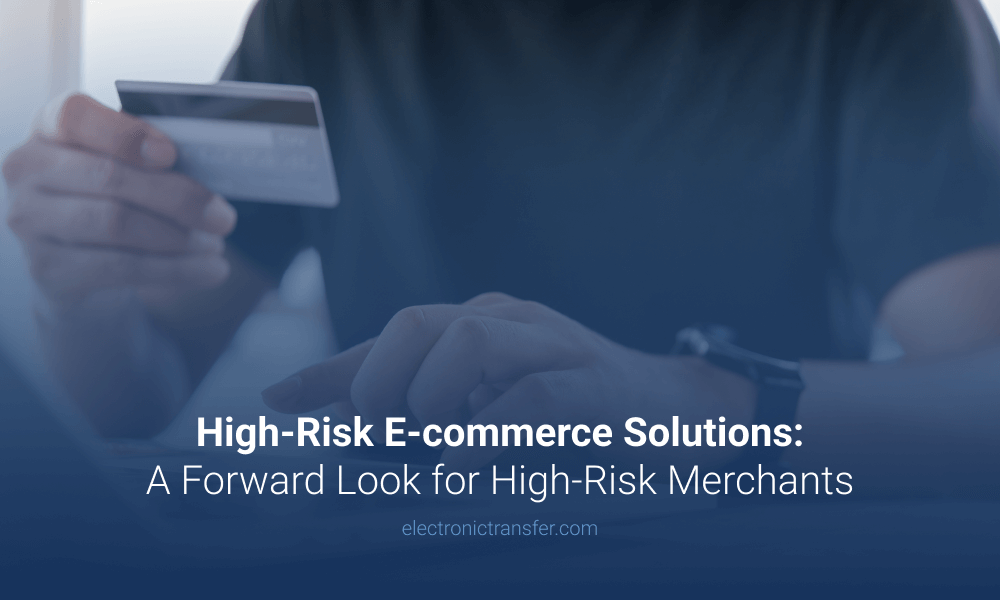High-Risk E-commerce Solutions: A Forward Look for High-Risk Merchants

When it comes to online businesses, not all companies are treated the same. Some are seen as more risky than others by banks and payment processors.
But what does this mean, and how will it affect the future of online shopping for high-risk merchants? Let’s explore the challenges these companies face and take a look at the possible solutions available.
What Are High-Risk Merchants?
High risk merchants are businesses that have a higher likelihood of chargebacks, fraud, or legal issues. These often include industries like online gambling, adult entertainment, FFL businesses, pharmaceuticals, subscription services, and certain financial services. The future of e-commerce for these merchants involves navigating those challenges while leveraging new technologies and strategies to grow their businesses.
Current Challenges for High-Risk Merchants in E-commerce
Right now, high-risk companies face several hurdles:
- Most popular e-commerce platforms have strict rules that make it hard for high-risk businesses to use their services. Among these platforms, providers such as Shopify, PayPal, Stripe, Square, and BigCommerce won’t even work with high risk generally.
- Many mainstream payment processors don’t want to work with high-risk businesses, making it harder for them to accept payments online.
- When they do find a payment processor, high-risk merchants often have to pay higher costs and fees.
- These businesses usually face stricter regulations and more frequent inspections of their operations.
- High-risk merchants are more likely to deal with customers asking for refunds or trying to commit fraud.
New Technologies Changing the Game
Despite the challenges, new technologies and strategies are opening up exciting and new opportunities for high-risk e-commerce.
Blockchain and Cryptocurrencies
Remember Bitcoin? The technology behind it, called blockchain, is set to revolutionize high-risk e-commerce. Here are a few examples:
- Streamlined transactions: Blockchain facilitates global payments in digital currencies, eliminating international transfer fees and currency conversion costs.
- Reduced chargeback fraud: Cryptocurrency transactions are typically irreversible, mitigating the risk of fraudulent chargeback claims for businesses.
- Enhanced privacy: Digital currencies offer increased anonymity, which is beneficial to sensitive transactions. For example, medical cannabis dispensaries could leverage blockchain to protect customer information.
- Smart contract automation: Blockchain enables self-executing contracts, allowing for automated processes such as instant payouts of winnings on online gambling platforms.
- Fractional ownership: Through tokenization, blockchain can divide high-value assets into smaller, tradable units, democratizing investment opportunities.
- Supply chain transparency: Blockchain provides robust tracking capabilities, allowing industries like pharmaceuticals to monitor product movement from manufacturing to retail, ensuring authenticity and preventing counterfeits.
Artificial Intelligence (AI) and Machine Learning Integration:
AI and blockchain are powerful tools that help risky online businesses solve common problems such as:
- Fraud detection: AI’s pattern recognition capabilities combined with blockchain’s immutable ledger create a formidable defense against fraudulent activities.
- Personalized user experience: Algorithms analyze user behavior to provide tailored product recommendations and services.
- 24/7 customer support: AI-powered chatbots offer round-the-clock assistance, complementing blockchain’s secure authentication protocols for sensitive inquiries.
- Dynamic pricing: Real-time price adjustments, based on market conditions, are possible. Blockchain provides a transparent record of these changes.
- Efficient KYC processes: Customer verification procedures are not only quicker, blockchain securely stores and manages this sensitive data.
- Cryptocurrency management: AI helps navigate complex digital asset trading and management, with blockchain ensuring transaction integrity and transparency.
- Handling digital cash: AI helps businesses deal with new types of money like Bitcoin while Blockchain makes sure the money is safe and can only be seen by the right people.
New Ways to Pay
The days of just using credit cards are over. High-risk merchants are embracing:
- Mobile Wallets: Services like Apple Pay and Google Pay are becoming more common.
- Buy Now, Pay Later: Options that let customers split their payments over time are gaining popularity.
Changing Rules and Regulations
The laws around online business are always changing. Being conscious of the rules and regulations is highly important. businesses should always keep an eye out for:
- Know their customer: Businesses need to be extra careful about verifying their customers’ identities.
- Anti-Money Laundering: There are strict rules to prevent illegal money from flowing through these businesses.
- Data protection: Laws like GDPR in Europe and CCPA in California mean companies need to be very careful with customer data in the future.
What Does the Future Hold?
Looking ahead, we can expect to see:
- Market consolidation: We may witness strategic mergers and acquisitions among smaller entities in high-risk industries, fostering increased competitiveness and market share.
- Normalization of fringe sectors: Certain industries currently classified as high risk may gradually transition into mainstream acceptance, driven by shifting societal norms, regulatory changes, and improved operational practices.
- Advanced risk evaluation methodologies: Financial institutions and payment service providers are likely to develop more nuanced and data-driven approaches to risk assessment, potentially leading to a reevaluation of current high-risk classifications for certain business models.
Wrap Up
The future of e-commerce for high-risk merchants is full of both challenges and opportunities. The key to success will be adaptability. Those who can quickly adjust to new technologies and changing customer expectations will be the ones who come out on top.
As the lines between high-risk and traditional e-commerce continue to blur, we may see a future where the term “high-risk merchant” becomes less relevant. Until then, these businesses will continue to push the boundaries of what’s possible in online retail, paving the way for innovations that could benefit all of e-commerce.


